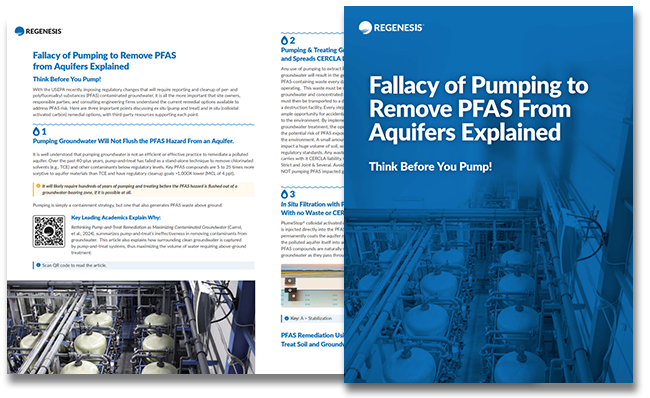The Fallacy of Pumping to Remove PFAS From Aquifers Explained
Highlights:
- Pumping Groundwater Will Not Flush the PFAS Hazard From an Aquifer.
- Pumping & Treating Groundwater Increases PFAS Exposure Risk
and Spreads CERCLA Liability. - In Situ Filtration with PlumeStop – Proven, Low Cost, PFAS Remediation
With no Waste or CERCLA Liability.
With the USEPA recently imposing regulatory changes that will require reporting and cleanup of per- and polyfluoroalkyl substances (PFAS) contaminated groundwater, it is all the more important that site owners, responsible parties, and consulting engineering firms understand the current remedial options available to address PFAS risk. The available options to remediate these contaminants involve ex situ mechanical pump-and-treat systems or in situ remediation. Both approaches contain PFAS plumes from migrating, thereby preventing exposure risk; however, in situ remediation has several important advantages. In situ remediation treats PFAS in place and below the ground, avoiding waste generation and related exposure risks. In situ remediation using colloidal activated carbon commercially available as Plumestop® and or SourceStop® offers rapid long-term effectiveness, while producing zero waste streams, and is less than 1/3 the cost of pump-and-treat. Considering these benefits, in situ remediation with PlumeStop and SourceStop will emerge as the only logical solution to prevent PFAS exposure risk at many impacted facilities.
Watch the webinar
In this webinar we were pleased to have Scott Wilson, President and CEO of REGENESIS share information on the misconceptions surrounding the use of pumping groundwater to flush PFAS from aquifers. In situ PFAS remediation was then explained and an overview was presented of performance expectations of this widely adopted remediation approach.

 Americas
Americas Europe
Europe Français
Français Deutsch
Deutsch Italiano
Italiano Español
Español




